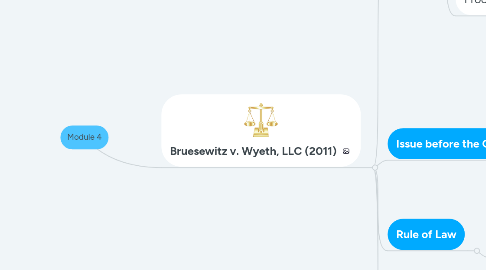
1. Bruesewitz v. Wyeth, LLC (2011)
1.1. Facts
1.1.1. Parties
1.1.1.1. Hannah Bruesewitz
1.1.1.2. Wyeth Pharmaceuticals
1.1.2. What Happened
1.1.2.1. Hannah was given a DTP vaccine in '92
1.1.2.1.1. Vaccine was manufactured by Wyeth
1.1.2.1.2. DTP Vaccine was recommended by the CDC
1.1.2.2. Hannah developed seizures within 24 hours of receiving the injection
1.1.2.2.1. Seizures did not subside
1.1.2.2.2. Hannah diagnosed with residual seizure disorder and developmental delay
1.1.2.3. in '98, Wyeth withdrew the vaccine used on Hannah from the market.
1.1.3. Procedural History
1.1.3.1. In '95 Bruesewitz family was denied damages by the United States Court of Federal Claims
1.1.3.2. In '05 they filed suit against Wyeth in Penn. State Court alleging negligent product design
1.1.3.2.1. Wyeth had the case moved to Eastern Penn. district court
1.1.3.3. Court ruled in favor of Wyeth citing 42 U. S. C. §300aa–22(b)(1) had preempted the suit
1.1.3.3.1. United States Third Circuit Court of Appeals affirmed
1.1.3.4. The Bruesewitzes appealed the Supreme Court
1.2. Issue before the Court
1.2.1. Whether the preemption provision in NCVIA bars state law design-defect claims against vaccine manufactures
1.3. Rule of Law
1.3.1. National Childhood Vaccine Injury Act (1986)
1.3.1.1. Enacted to prevent the collapse of the vaccine industry under tort liability
1.3.1.1.1. Provides liability protection to manufactures from vaccines unavoidable adverse side effects
1.3.1.2. Plaintiff can not claim design defect, must prove regulatory failures.
1.4. Application
1.4.1. Wyeth claims protection through NCVIA
1.4.1.1. Vaccine is recommended by the CDC, classified as protected in NCVIA, and lists seizures as a potential side-effect of the drug.
1.4.1.1.1. The court cites NCVIA stating "No vaccine manufacturer shall be liable in a civil ac- tion for damages arising from a vaccine-related injury or death associated with the administration of a vaccine"
1.4.1.2. Shot was administered after '86
1.4.1.3. quid pro quo
1.4.1.3.1. Wyeth contributes to the no-fault compensation program via vaccination taxes. Providing protection from tort liability.
1.4.2. Plaintiff can not claim design defect as subject of tort
1.4.2.1. Has the burden of proving Wyeth...
1.4.2.1.1. Did not meet regulatory requirements,
1.4.2.1.2. intentionally withheld information
1.4.2.1.3. Engaged in criminal activity
1.4.2.2. The "even-though" clause
1.4.2.2.1. Vaccine manufactures must have already taken steps for a side-effect to have been considered unavoidable
1.5. Conclusion
1.5.1. The court affirms the judgment of the court of appeals
1.5.1.1. NCVIA preempts all design defect claims against vaccine manufactures
